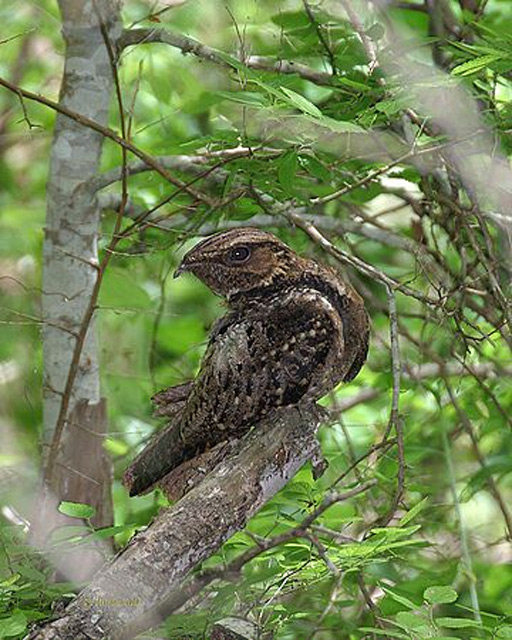The Chuck-will's-widow is the largest of the North American Nightjars. It derives its name from its distinctive call, which some mistake for its more well-known cousin, the Whip-poor-will. During a bright, moon-lit night, the male may call its name several thousand times between dusk and dawn. The genus name is a Latin form of the Greek words meaning 'goat milker.' The Greeks believed they flew in the fields to take milk from the goats during their nightly activities.
Species Description:
Length: 31 cm
Physical characteristics: The Chuck-will's-widow is a pigeon-sized bird and larger than the Whip-poor-will. It is mottled gray-brown with a brown throat and small white or buffy neck band. The outer tail feathers of the males have large white patches with the tips being a buff-brown, but females lack white on the outer tail feathers. The head is large with a very small bill; tail is long and rounded. The mouth of the male is surrounded by stiff bristles.
Voice: Song is repetitive, distinctive, and in four syllables, sounding its name and dropping in pitch at the end. The initial 'chuck' is soft and sometimes inaudible, with the remaining 'wills-widow' more of a whistle. It occasionally gives other quiet growling or clucking sounds.
Breeding habitat:
This species favors mixed oak and pine forests for nesting, but also inhabits evergreen oak groves, forest edges, and woodlands along river courses. During migration and in winter, it frequents open woodland and scrub thickets. The only nest known from the park had in late May 1991 and was in old growth pines that had been recently thinned for Red-cockaded Woodpecker habitat.
Nest:
No nest is constructed. Eggs are laid on the ground on dead leaves, usually at the edges of forests, near roads or other clearings, and with little or no undergrowth around the eggs. The Chuck-will's-widow shows high fidelity from one year to the next and will often nest within 3 meters of previous nest sites.
Eggs:
A clutch consists of 1 to 4 (most often 2) dull white eggs with delicate pale lilac markings and a few distinct brownish gray spots. 35mm (1.4 in.).
Chick development:
The female and male incubate the eggs for approximately 20 days. The young are semi-precocial and are ready to fly at about 17 days after hatching. If disturbed, the adults may move the eggs or nestlings from the nest site. The young and adults stay together as a group until late summer.
Diet:
The diet of the Chuck-will's-widow is highly variable and consists of night-flying insects such as moths and beetles, amphibians, birds (warblers, sparrows, wrens, and hummingbirds), and bats. The records of this species eating birds have mostly been during migration. It forages on the wing and uses its enormous mouth and bristles to scoop up prey and swallow it whole--the wide-open mouth of an adult can measure 2 inches from corner to corner.
Conservation Biology:
The Chuck-will?s-widow has been declining in some areas, most likely due to land use changes. It is considered common within appropriate habitat, however, it is listed as a moderate priority species. The most significant declines have occurred in the Gulf Coastal Plain, Oklahoma, and Tennessee, but no serious reductions are noted across its entire range. Threats include breeding and wintering habitat loss and degradation and pesticide exposure from foraging over pastures and fields. Because of gypsy moth infestations in many parts of the northeastern U.S., requiring pesticide use on large portions of oak forests, the foraging opportunities for this species may be restricted, especially as the moth advances into the southeastern states.
Breeding: The Chuck-will's-widow ranges from southern Iowa, Kansas, Ohio, Indiana, New Jersey, and Long Island southward to south-central Texas, the Gulf Coast, and southern Florida.
Winter: This species winters chiefly in the West Indies and from Mexico to northern South America.
The Chuck-will's-widow is fairly common to common in late spring and summer in the coves and valleys outside the Great Smoky Mountains National Park boundaries, but a very uncommon summer resident and migrant in the park. It has been recorded at Cades Cove, Sugarlands, and Gatlinburg. It frequents open fields near woodland edges. There is one nesting record for the park near Tabcat Creek.
References:
Alsop, F. J. 1991. Birds of the Smokies. Great Smoky Mountains Natural History Association, Gatlinburg, TN.
Chapman, F. M. 1934. Birds of Eastern North America. Appleton-Century Company, New York.
Georgia Wildlife Website. 2005. Georgia Museum of Natural History, University of Georgia, Athens, GA. http://museum.nhm.uga.edu/gawildlife/birds.html.
Gough, G. A., Sauer, J. R., Iliff, M. Patuxent Bird Identification Infocenter. 1998. Version 97.1.
Patuxent Wildlife Research Center, Laurel, MD. http://www.mbr-pwrc.usgs.gov/id/framlst/infocenter.html.
Nature Conservancy Species Management Abstract, Chuck-Will's-Widow. 1999. The Nature Conservancy, Arlington, VA.
Robinson, J. C. 1990. An Annotated Checklist of the Birds of Tennessee. The University of Tennessee Press, Knoxville, TN.
Sibley, D.A. 2003. The Sibley Field Guide to Birds of Eastern North America. Alfred A. Knopf, New York.
Animalia
Chordata
Aves
Caprimulgiformes
Caprimulgidae
Phenology
Gmelin

